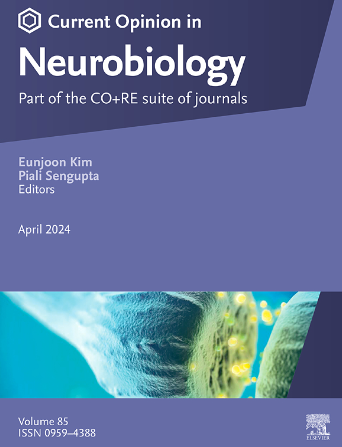突发放电是初级感觉皮层习得性复合刺激的表现
IF 5.2
2区 医学
Q1 NEUROSCIENCES
引用次数: 0
摘要
每种感觉模式的初级皮层区域占据了哺乳动物新皮层的重要部分。除了映射基本的感觉特征,如视觉对象的方向或声音频率,这些区域可能在感觉处理中发挥更广泛的作用。在这里,我们回顾了最近的进展,我们的感觉表征的理解通过一个独特的神经元放电模式称为爆破,特别关注第2/3层(L2/3)锥体神经元。虽然单一特征输入的映射保存在初级感觉皮质中,但单个L2/3锥体神经元接收来自多个基本特征的异质输入。这些输入的共同激活可以诱导爆发,形成稀疏但持久的复合感官刺激表征。与基本的随时间变化的感官特征地图不同,L2/3中经验驱动的爆发模式在很长一段时间内保持稳定。值得注意的是,这些爆发表征是整体的,因为单一特征的成分刺激很少引起这种活动。我们认为L2/3中的这些整体爆发神经元(HB神经元)在整合感官体验、产生持久、稀疏和可靠的表征方面发挥着至关重要的作用,这些表征可能作为现实世界复杂性中长期记忆的基石。本文章由计算机程序翻译,如有差异,请以英文原文为准。
Burst firing represents learned composite stimuli in primary sensory cortices
The primary cortical areas of each sensory modality occupy a significant portion of the mammalian neocortex. Beyond mapping basic sensory features, such as visual object orientation or sound frequency, these regions may play a broader role in sensory processing. Here, we review recent advances in our understanding of sensory representations through a unique neuronal firing mode called bursting, with a particular focus on layer 2/3 (L2/3) pyramidal neurons. While maps of single-feature inputs are preserved in primary sensory cortices, individual L2/3 pyramidal neurons receive heterogeneous inputs from multiple basic features. The co-activation of these inputs can induce bursting, forming sparse yet persistent representations of composite sensory stimuli. Unlike basic sensory feature maps, which drift over time, experience-driven bursting patterns in L2/3 remain stable over long periods. Notably, these bursting representations are holistic, as single-featured component stimuli rarely elicit such activity. We propose that these holistic bursting neurons (HB neurons) in L2/3 play a crucial role in integrating sensory experiences, generating durable, sparse, and reliable representations that may serve as building blocks of long-term memory in the complexity of the real-world.
求助全文
通过发布文献求助,成功后即可免费获取论文全文。
去求助
来源期刊

Current Opinion in Neurobiology
医学-神经科学
CiteScore
11.10
自引率
1.80%
发文量
130
审稿时长
4-8 weeks
期刊介绍:
Current Opinion in Neurobiology publishes short annotated reviews by leading experts on recent developments in the field of neurobiology. These experts write short reviews describing recent discoveries in this field (in the past 2-5 years), as well as highlighting select individual papers of particular significance.
The journal is thus an important resource allowing researchers and educators to quickly gain an overview and rich understanding of complex and current issues in the field of Neurobiology. The journal takes a unique and valuable approach in focusing each special issue around a topic of scientific and/or societal interest, and then bringing together leading international experts studying that topic, embracing diverse methodologies and perspectives.
Journal Content: The journal consists of 6 issues per year, covering 8 recurring topics every other year in the following categories:
-Neurobiology of Disease-
Neurobiology of Behavior-
Cellular Neuroscience-
Systems Neuroscience-
Developmental Neuroscience-
Neurobiology of Learning and Plasticity-
Molecular Neuroscience-
Computational Neuroscience
 求助内容:
求助内容: 应助结果提醒方式:
应助结果提醒方式:


